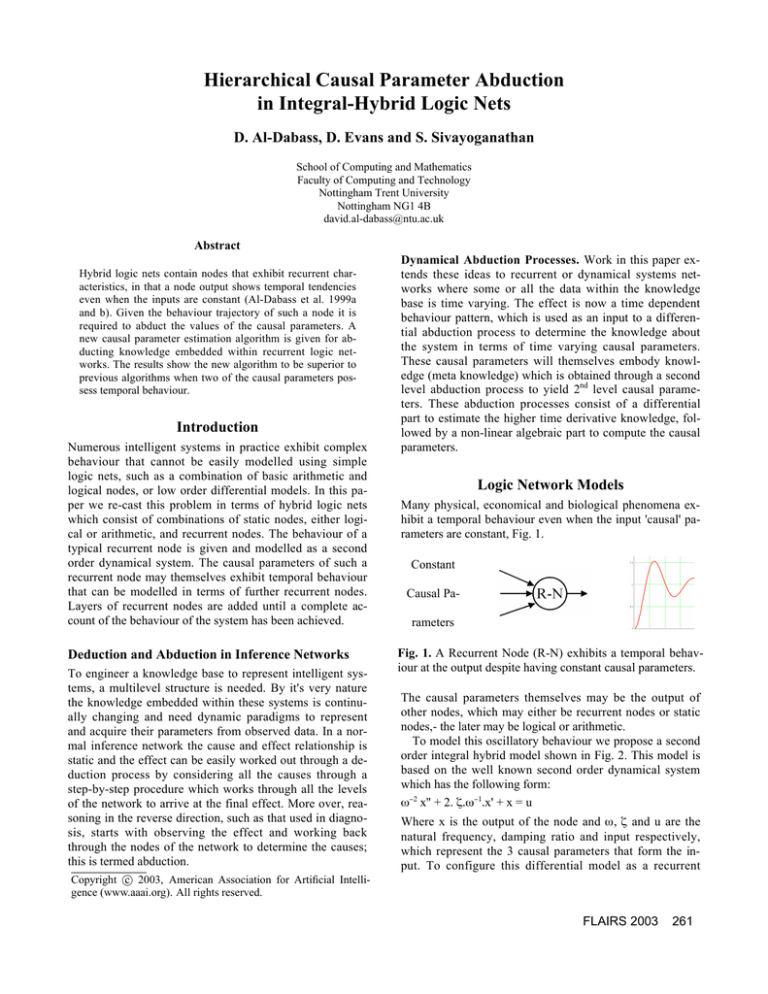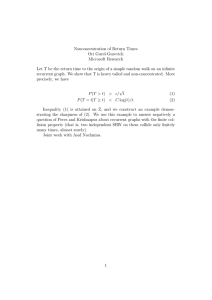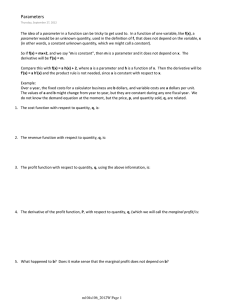
Hierarchical Causal Parameter Abduction
in Integral-Hybrid Logic Nets
D. Al-Dabass, D. Evans and S. Sivayoganathan
School of Computing and Mathematics
Faculty of Computing and Technology
Nottingham Trent University
Nottingham NG1 4B
david.al-dabass@ntu.ac.uk
Abstract
Hybrid logic nets contain nodes that exhibit recurrent characteristics, in that a node output shows temporal tendencies
even when the inputs are constant (Al-Dabass et al. 1999a
and b). Given the behaviour trajectory of such a node it is
required to abduct the values of the causal parameters. A
new causal parameter estimation algorithm is given for abducting knowledge embedded within recurrent logic networks. The results show the new algorithm to be superior to
previous algorithms when two of the causal parameters possess temporal behaviour.
Introduction
Numerous intelligent systems in practice exhibit complex
behaviour that cannot be easily modelled using simple
logic nets, such as a combination of basic arithmetic and
logical nodes, or low order differential models. In this paper we re-cast this problem in terms of hybrid logic nets
which consist of combinations of static nodes, either logical or arithmetic, and recurrent nodes. The behaviour of a
typical recurrent node is given and modelled as a second
order dynamical system. The causal parameters of such a
recurrent node may themselves exhibit temporal behaviour
that can be modelled in terms of further recurrent nodes.
Layers of recurrent nodes are added until a complete account of the behaviour of the system has been achieved.
Deduction and Abduction in Inference Networks
To engineer a knowledge base to represent intelligent systems, a multilevel structure is needed. By it's very nature
the knowledge embedded within these systems is continually changing and need dynamic paradigms to represent
and acquire their parameters from observed data. In a normal inference network the cause and effect relationship is
static and the effect can be easily worked out through a deduction process by considering all the causes through a
step-by-step procedure which works through all the levels
of the network to arrive at the final effect. More over, reasoning in the reverse direction, such as that used in diagnosis, starts with observing the effect and working back
through the nodes of the network to determine the causes;
this is termed abduction.
Dynamical Abduction Processes. Work in this paper extends these ideas to recurrent or dynamical systems networks where some or all the data within the knowledge
base is time varying. The effect is now a time dependent
behaviour pattern, which is used as an input to a differential abduction process to determine the knowledge about
the system in terms of time varying causal parameters.
These causal parameters will themselves embody knowledge (meta knowledge) which is obtained through a second
level abduction process to yield 2nd level causal parameters. These abduction processes consist of a differential
part to estimate the higher time derivative knowledge, followed by a non-linear algebraic part to compute the causal
parameters.
Logic Network Models
Many physical, economical and biological phenomena exhibit a temporal behaviour even when the input 'causal' parameters are constant, Fig. 1.
Constant
Causal Parameters
Fig. 1. A Recurrent Node (R-N) exhibits a temporal behaviour at the output despite having constant causal parameters.
The causal parameters themselves may be the output of
other nodes, which may either be recurrent nodes or static
nodes,- the later may be logical or arithmetic.
To model this oscillatory behaviour we propose a second
order integral hybrid model shown in Fig. 2. This model is
based on the well known second order dynamical system
which has the following form:
w-2 x'' + 2. z.w-1.x' + x = u
Where x is the output of the node and w, z and u are the
natural frequency, damping ratio and input respectively,
which represent the 3 causal parameters that form the input. To configure this differential model as a recurrent
c 2003, American Association for Artificial IntelliCopyright °
gence (www.aaai.org). All rights reserved.
FLAIRS 2003
261
network, a twin integral elements are used to form a hybrid
integral-recurrent net as shown in Fig. 2.
Constant
Causal parameters
Algorithm 1: Three-Points in x, x' and x''.
This algorithm yields the following expressions for estimated w, z, and u:
u
w
Temporal
behaviour
z
Fig. 2. Hybrid integral-logic net to model the temporal behaviour of the node in Fig. 1
Hierarchical Causal Parameters with
Temporal Behaviour
The output trajectory of the system may be more complex
than can be represented by a simple second order differential model. In this case each causal parameter may itself be
modelled as having a dynamical behaviour, which may or
may not be oscillatory. One such case is where two of the 3
causal parameters have 2nd order dynamical characteristics,
as shown in Fig. 3.
uu
u
wu
zu
u
uw
ww
w w
z
Ew2 = [D''13.D'12 - D''12.D'13] / [D12.D'13 - D13.D'12]
Ez = [-Ew-2.D''12 -D12 ] / [2. Ew-1. D'12]
Eu = Ew-2. x1'' + 2. Ez.. Ew-1 . x1' + x1
Algorithm 2: Two-Points and One Extra Derivative.
This algorithm gives the following expressions for estimated w, z, and u:
Ew2 = [(D'12). ( D'''12 ) - ( D''12 )2]/ [(D'12 )2 - D12 . D''12]
Ez = [-Ew-2.D''12/D'12 - D12 /D'12 ] / [2. Ew-1 ]
Eu = Ew-2. x1'' + 2. Ez.. Ew-1 . x1' + x1
Single Point Algorithms
These are classified according to the order of the parameter
variation used in the derivation, i.e. constant, first order
polynomial (constant u' but u''=0), 2nd order polynomial
(constant u'' but u'''=0) etc .
Algorithm 3: Constant Parameters. Consider using the
1st to 4th time derivatives at a single point. Given the second order system:
w-2 x'' + 2. z.w-1.x' + x = u
(1)
Differentiate with respect to t and divide by x'':
zw
w-2 x'''/ x'' + 2. z.w-1 + x'/ x'' = 0
Fig. 3. Two of the causal parameters of the final node have temporal
behaviour modelled as 2nd order hybrid integral recurrent nets.
Knowledge Abduction Algorithms
The knowledge embedded in such a model is represented
by the parameters of the various recurrent nodes. By taking
measurements of the system trajectory, tracking algorithms
are employed to estimate the values of these parameters on
line. Parameter tracking algorithms fall into several categories depending on the manner of accessing relevant information from the trajectory of the object and the order of
parameter variation used in the derivation of the relevant
models.
Multipoint Algorithms
Several algorithms are easily derived to estimate values of
causal parameters using as many points from the trajectory
262
as necessary to form a set of simultaneous algebraic
equations. The parameters to be estimated form the
unknown variables and the trajectory values and their time
derivatives form the constant parameters of these equations
(Al-Dabass 1999a and b).
FLAIRS 2003
(2)
and differentiate with respect to t again to give:
w-2.[(x''. x'''' - x'''2) / x''2] + 0 + [(x''2 – x'. x''') / x''2] =0
(3)
We get expressions for estimated w, estimated z, using (2),
and estimated u:
Ew2 = [x''. x'''' - x'''2] / [x'. x''' - x''2]
Ez = -[Ew-2 x''' + x'] / [2. Ew-1.x'']
Eu = Ew-2. x'' + 2. Ez. Ew-1 . x' + x
Algorithm 4: First Order Parameters. Let the first time
derivative of u to be non zero. For simplicity assume that
both a and b (the coefficients of x'' and x' to make symbol
manipulation easier) to be constant and hence disappear on
first differentiation. The extra information needed for u' to
be non zero is extracted from the 5th time derivative of the
trajectory.
a.x'' + b.x' + x = u
(4)
Differentiate wrt to t and assume u' is non zero to give:
a.x''' + b.x'' + x' = u'
(5)
Differentiate again and set u'' = 0 gives:
a.x'''' + b.x''' + x'' = 0
(6)
Divide Equation 4 by x''' to isolate b:
a.x''''/x''' + b + x''/x''' = 0
(7)
Differentiate again to eliminate b:
a.(x'''''.x'' - x''''2 )/x'''2 + (x'''2 - x'' . x'''')/x'''2 = 0
(8)
Re-arranging for a gives:
a = (x'' . x'''' - x'''2 )/(x''''' . x''' - x''''2 )
(9)
Solve for b by substituting a from equation (9) into equation (7):
b = -x''/x''' - a.x''''/x'''
Substituting for a and manipulating gives:
b = (x''.x''''' - x'''.x'''')/(x'''''2 - x''' . x''''')
(10)
We can now substitute these values for a and b into equation 4 to solve for u,
u = a.x'' + b.x' + x
x2
0
0
2
w .x1
0
x
G. x1
0
0
D( t , x)
0
x3
G. G. x1
x3
G. G. G. x1
0
G. G. G. G. x1
G. G. G. G. G. x1
Z
2
w .u
2 .z .w .x2
x4
x3
x3
x3
x4
x4
x4
x5
x5
x5
x6
x6
x7
Rkadapt ( x, t0 , t1 , N , D )
Fig. 6. A cascade of 5 recurrent cells plus the 2nd order
trajectory model.
Derivative Abduction Architecture
The structure of each cell of the recurrent network is
shown in Figure 4. The output of each cell feeds the input
to the next one to generate the next higher order time derivative, see Fig. 5. The output of the system and the cascade
of 1st order recurrent network filters were simulated using
the 4th order Runge-Kutta method in Mathcad. The derivatives vector is shown in Figure 6. Figure 7 shows a typical
set of high order time derivatives abducted from the output
trajectory of a system displaying temporal behaviour.
Fig. 7. A typical set of time derivatives abducted from the
trajectory of an oscillatory system.
Results and Discussion
Algorithm 3 using Constant Parameters
T his algorithm uses a single time point but two further
Fig. 4. A single stage recurrent sub-net using an integrator in
the feedback path to abduct the derivative x' = w(x-E(x))
X
Recurrent Sub-net 1
X'
X'
Recurrent Sub-net 2
X''
X''
Recurrent Sub-net 3
X'''
X'''
Recurrent Sub-net 4
X''''
time derivatives compared to Algorithm-1. The filter cascade is increased by one again to provide a continuous estimate of the 4th time derivative x''''. The separation problem disappears altogether now to provide a continuous estimate of all parameters at each point on the trajectory.
Program 3 [Zreiba, 1999, Appendix A] was run, and the result of the estimation are given in Fig. 8; which shows fast
and accurate convergence.
Fig. 5. A 4th order recurrent network to abduct 1st to 4th
time derivatives.
FLAIRS 2003
263
1.854
1.8
u
n1
1.6
1
u1
n1
1.4
1
Z
n1 , 5
1.2
a
n1
10
1
a1
n1
b
n1
0.8
100
b1
n1
0.6
10
Ew
n1
0.4
10000
Ew1
n1
0.2
10000
Fig. 8. Estimated constant omega, zeta and u
0
0.037
Discussion. Estimated values for constants parameters
were close to the desired set values. The derived algorithms estimated w, z and u for a good range of values: w
from 1 to10, z between +/- (0.01 to 1), and u between +/(0.5-40), and gave accurate estimates. Estimation errors
decreased as w increased, particularly for small z (less
than 0.5): where oscillation provided wide variation in the
variables to decrease errors. The differences between the
(simulated) system time derivatives (x, x' and x'') and their
estimates from the filter cascade depended on G (the cutoff frequency): high G provided more accurate estimation
of derivatives but made the algorithms prone to noise and
vice versa. Another disadvantage of high G from the
simulation point of view is that simulation time increased
considerably due to the integration routine adapting to ever
smaller steps. The algorithms provided progressively faster
convergence with Algorithm-3 being the fastest to converge.
Results For Algorithm 4
Mathcad routines were set up to generate the input u as
second order system with its own parameters of natural
frequency, damping ratio and input. The input subsystem
damping ratio was set to 0.05 to generate an oscillatory behaviour for long enough to test the parameter tracking algorithm thoroughly. The frequency of the input was set to
16 radians per second, one quarter of the frequency of the
object natural frequency. The derivative generation cascade
was increased by one to produce the fifth time derivative.
The results are shown in Fig. 9 below.
The actual input is the smooth sinusoidal trace, which
gives approximately one and one quarter cycles over a period of half a second as expected, i.e. 16 radians/s = 2.546
Hertz. The widely oscillating jagged trace shows the results
from the previous constant u derivation algorithm which is
failing completely to track the input parameter.
264
FLAIRS 2003
0.2
0
10
50
100
150
200
n1
250
300
350
400
400
Fig. 9. Results of the high order algorithm
1.854
1.8
u
n1
1.6
1
u1
n1
1
Z
n1 , 5
1.4
1.2
a
n1
10
1
a1
n1
b
n1
0.8
100
b1
n1
10
Ew
n1
10000
0.6
0.4
Ew1
n1
10000
0.2
0
0.023
0.2
0
10
50
100
150
200
n1
250
300
350
400
400
Fig. 10. Results of the high order algorithm for one second
integration time.
The slightly distorted sinusoidal trace shows the result of
the new algorithm, which is managing to track the input
much more closely; however it start to diverge slightly near
the peak of the cycle but then returns to track it well right
down and round the lower trough of the input trajectory.
To check the quality of tracking as time progresses, a
second set of results was obtained with integration time
extended to one second to give two and a half cycles. The
results are shown in Fig. 10. It is clear that tracking remain
stable. It is interesting to note that the old algorithm while
completely failing to track the upper half of the input trajectory it seems to track it well during the its lower half but
not as well as the new algorithm.
Figures 11 and 12 show the case when two of the causal
parameters are changing. It is clear that the new algorithm
provide much better tracking than the previous algorithm.
good tracking over an extended period of time. This algorithm proved to be far superior to the third algorithm which
relied on the assumption of constant input in the derivation.
References
Al-Dabass, D.; Zreiba, A.; Evans D.; and Sivayoganathan, K.
1999a. Simulation of Three Parameter Estimation Algorithms for
Pattern Recognition Architecture. UKSIM'99, Conference Proceedings of the UK Simulation Society, St Catharine's College,
Cambridge, 7-9 April 1999, pp170-176, ISBN 0-905488-38-5,
available online at URL: http://ducati.doc.ntu.ac.uk/uksim/ papers/moller/dad.doc.
Fig. 11. The u causal parameter (pink trace) being
tracked using algorithm-3 (red trace) and the new algorithm (blue trace). The black trace is the node output
trajectory.
Al-Dabass, D.; Zreiba, A.; Evans D.; and Sivayoganathan, K.
1999b. "Simulation of Noise Sensitivity of Parameter Estimation
Algorithms, Simulation'99 Workshop, UCL, London, 29 October
1999, pp32-35.
Goodwin, C. 1997. Real Time Recursive Block Parameter Estimation of Second Order Systems. Ph.D. thesis, School of Computing & Mathematics, The Nottingham Trent University, Nottingham.
Al-Dabass, D.; Evans D.; and Sivayoganathan, K. 2002. Derivative Abduction using a Recurrent Network Architecture for Parameter Tracking Algorithms. IEEE 2002 Joint Int. Conference
on Neural networks, World Congress on Computational Intelligence, pp1570-1575, May 12-17, Hawaii.
Kailath, T. 1978. Lectures on Linear Least-Squares Estimation.
CISM courses and lectures No. 140, Spring-Verlag, New York.
Gersch, W. 1974. Least Squares Estimates of Structural System
Parameters using Covariance Function Data. IEEE Trans. On
auto. Control, 19(6).
Fig. 12. The w causal parameter (pink trace) being
tracked using algorithm-3 (red trace) and the new algorithm (blue trace). The black trace is the node output
trajectory.
Conclusions and Future Work
A model for the recurrent nodes of hybrid logic nets was
put forward to model the complex behaviour of intelligent
systems. To abduct the values of the causal parameters a
number of parameter tracking algorithms were presented.
Two of the algorithms used multiple points from the trajectory, 3 for the first algorithm and 2 points for the second. Two single point algorithms were presented: one that
assumed constant parameters and used higher time derivatives of the trajectory (up to 4th), and a second algorithm
that used additional information from a 5th time derivative
of the trajectory to allow one of the parameters, the input
parameter u, to have a non zero first time derivative.
The fourth algorithm was tested for its ability to track the
input parameter for a reduced order model. The test involved the generation of a lightly damped second order recurrent net. The results showed the algorithm maintaining
Man, Z. 1995. Parameter-Estimation of Continuous Linear Systems using Functional Approximation. Computers and Electrical
Eng. Vol. 21, No. 3, pp. 183-187.
Cawley, P. 1984. The reduction of Bias Error in Transfer Function Estimates using FFT-based Analysers. Journal of Vibration,
Acoustics, Stress and Reliability in Design, pp.29-35.
Dewolf, D.; and Wiberg, D. 1993. An Ordinary DifferentialEquation Technique for Continuous Time Parameter Estimation.
IEEE Trans. On Auto. Control, Vol. 38, No. 4, PP. 514-528.
Kalman, R. 1960. A New Approach to Linear Filtering and Prediction Problems. Tans. Of SIAM: Journal of Basic Eng., series
D, 82, PP. 35-45.
Mathcad 7 Professional Program.
Zreiba, A. 1999. MathCad Programs for Parameter Estimation.
Research Report, School of Computing & Mathematics, The
Nottingham Trent University, Nottingham.
FLAIRS 2003
265





